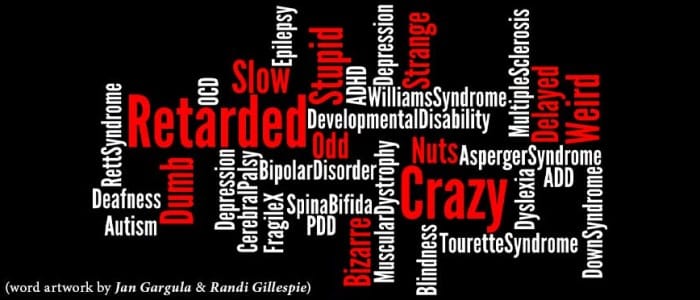![]() Language is powerful. It can be used to inspire and empower, but also to dehumanize and ostracize. In the special needs community, we face a language minefield that creates challenges for even our best-spoken advocates. We hope that this article generates discussions, reflections, and actions that contribute to an improved use of language in the special needs community.
Language is powerful. It can be used to inspire and empower, but also to dehumanize and ostracize. In the special needs community, we face a language minefield that creates challenges for even our best-spoken advocates. We hope that this article generates discussions, reflections, and actions that contribute to an improved use of language in the special needs community.
The children’s rhyme, “sticks and stones may break my bones, but words will never harm me,” first appeared in 1862. While the motivation for the rhyme is to encourage children not to retaliate with physical actions when they are taunted or called names, the reality is that words and phrases can do damage and their effects can linger far longer than physical wounds. The simple fact is that language is powerful. This is especially true in the special needs community where a language minefield exists that must be navigated by those trying to be descriptive without being offensive.
Retarded is not the only problematic word in the special needs community, but it serves as an example of how words can become hurtful if they progress from the medical lexicon to common slang. According to Merriam-Webster, the first use of retarded as an adjective describing an individual’s intellectual or emotional development occurred in 1895. The New England Journal of Medicine used the term as long ago as 1915. While used in the medical community for at least one hundred years, recently there has been a campaign to eliminate the use of the “R-word.”
In May of 2014, the Supreme Court first used the term intellectual disability in place of mentally retarded when striking down the use of a strict IQ cutoff in a Florida case. Their decision to change the language they used was likely influenced by the “Spread the Word to End the Word” campaign that began in 2009 and has been supported by Special Olympics and Best Buddies. Many leaders in the special needs community heralded the language change as an opportunity to leave the “R-word” in the past.
There are two challenges in mastering the use of non-offensive language in the special needs community. First, there are numerous words that can be problematic. Take the word “crazy” for example. The similarities between “retarded” and “crazy” strike me as obvious. Both are commonly used as a way to belittle someone based on their actions or intellectual challenges. Both have roots in the medical community. Unfortunately, society’s careless use of these and other words leads to stigma and suffering by those who are impacted by the words.
Another challenge we face is the double-standard we deliver as advocates. When campaigning for rights and benefits for those who have special needs challenges, we often resort to labels and words that diminish individuals’ abilities in an effort to get attention from lawmakers and donors. We need others to understand that those with special needs need more assistance.
At the same time, we want society to see the potential in all individuals and therefore we often speak in positive tones about current abilities, development, and hope for the future.
Ironically, the language minefield is not always well-navigated even by those who are most concerned about the damage language can do. In one recent conversation I had with an advocate for individuals with developmental disabilities, she used the word crazy twice without hesitation. While my use of the “R-word” would have offended her and likely terminated our discussion, she seemed oblivious to the pain that the “C-word” inflicts in the mental illness community.
In addition to eradicating the use of certain words, there has been a growing movement in the special needs community for people-first language. The concept is that the person comes first and the condition follows. An example would be “the child who has a disability.” This contrasts with the more efficiently written “the disabled child.” However, the difference is meaningful. In the first case, the condition is simply one aspect of who the person is. In the second case, disability defines the person. While this more sensitive approach is generally considered preferable, there are those in the special needs community who believe that separating the condition from the person suggests that the condition makes the person “less than” their peers and they would rather embrace the condition and seek acceptance for the person as an individual.
As advocates in the special needs community, we face numerous hurdles. Unfortunately, language is one that is not easily overcome despite the improvements that are being made. We must remain tolerant and understanding of those who unintentionally use hurtful language while using those moments as teaching opportunities. While it is a tiring process to always be educating and advocating, it remains the path to future progress.
The post Beware of the Language Minefield appeared first on Oak Wealth Advisors, LLC.





